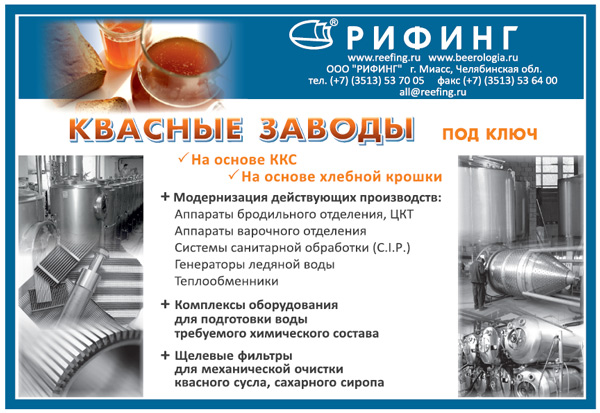Last two years became «bad times» for brewing industry. First in 2010 excise taxes have been elevated three times. Then 2011 brought federal law 171 on «State Regulation of Production and Sales Volume of Ethanol, Alcohol and Alcohol-Containing Products». The legislative proposal stroke seriously medium-sized concerns and especially small businesses among beer producers. The issue that is still on the table is licensing of manufacture and sales volume of beer.
Alexander Pilipenko, Sales and Marketing Department Chief REEFING Co., Ltd

Lawmakers gave time out to brewing field till January 1st, 2013 for declaring of issued production volume and shop equipping with counters. Obviously it effects negatively both existing brewing industry members and the field attraction as an investment by the way of new beer companies establishing. Market lies still. Some decided to be finished with beer business. Others are waiting and trying to adapt new conditions.
In such atmosphere the question of business profitability is appeared to be relevant. At the present moment average prime cost of one liter of beer including excise tax amounts to 30 rubles with VAT (relating to «Pilsner»-type Finnish amber malt, Perle90 sort of German granulated hop, «Fermentis» faex). For small businesses and medium-sized concerns the main market has been presented by small-scale mobile single stores of «live» beer. Due to low disbursing price and high quality of the product they were able to keep their customers and provide their profitability through disposal volume. Now this sector of market is going to be closed. And the traditional Russian call arises — What should we do? The question — Who is in fault? — is out of discussion. The answer to it is evident. So there are several options to get out:
1. To adapt requirements of federal law 171 and deal with local trade stores which meet those, or open your own ones.
2. To try sales through major outlet chains on local level.
3. To head to HoReCa area.
4. To diversify your product line.
The first option will be used by everyone. The second is long and winding road – not everyone will reach its end. The third is appropriate and attractive in metropolis with developed system of HoReCa industry. The fourth one is also quite catchy in the situation at hand. Actually it is obvious that to increase business profitability it would be good to use all four of them.
I’d like to be more precise with your shop product line diversifying. What else could you produce at brew house besides beer?
First is bottled water. 0,5 to 5 liters bottles. There is water treating system installed already, what is left is to buy equipment for blowing, bottling and labeling (used versions can be applied). The market of bottled water is growing fast letting new members come in. Then you also can try different tastes of water (blending option), can make it sparkling (add carbonator).
Second of what you can do is to establish production of kvass. For kvass production the same equipment is used as the one provided for brew house where beer is brewed. For instance to make kvass of concentrate leavened wort available mash brewing apparatus can be used as syrup pan. You already have hot water boiler. As a tank for syrup storage any tank with steam jacket will be suitable. For processes of fermentation, cooling, extraction, purification and blending cylinder-conic tanks and beer fermentation tanks with bumped head are perfect fit. Thus with minimum costs you can start kvass production. By the way for kvass ale yeast which you are used to work with can be utilized.
To make a decision about kvass production launch you should clarify the following:
1.To explore local kvass market. To evaluate its demand volume.
2. Based on the market analysis to decide production volume and type of containers (kegs, PET preforms, pressure tanks, barrels).
3. To draw a plan of shop modernization (additional tanks, increasing power of refrigeration compartment, CIP enlargement etc.)
Why is it effective to produce kvass?
1. Concentrate leavened wort kvass prime cost is 6 to 8 rubles per liter including VAT.
2. Terms: kvass is ready to be bottled after 3 days (unlike beer where the cycle is 20 to 60 days).
3. Customer shows interest to «live» kvass. Demand for kvass is growing fast.
4. At the present moment kvass market demonstrates annual stable development. In the coming years its dynamic will be 20-30% per year. That is indicative for growth market. For comparison: during recent recessionary years beer field was showing negative results.
Major beer makers have directed their attention to kvass (Stepan Pazin plant, Baltica, Ochakovo and others). Now most of brewing companies have kvass production in their plans for business development. And this is understandable — this product is the way more profitable than beer. But here we need to take into account clearly defined seasonality of kvass. Though major brewery concerns have already started to form all-seasonal culture of kvass consumption (which helps a lot small and middle-sized kvass businesses).
Federal law 171 does not touch kvass.
Time comes to act. Time comes to change. We invite you to take your place at kvass market!


